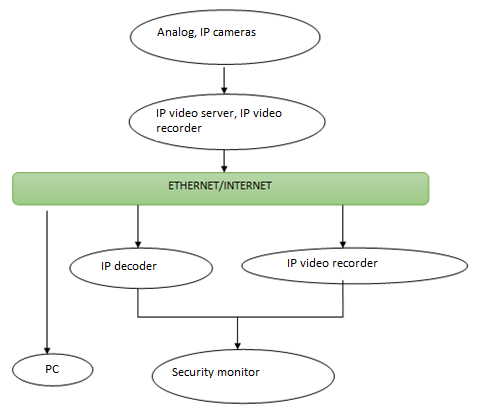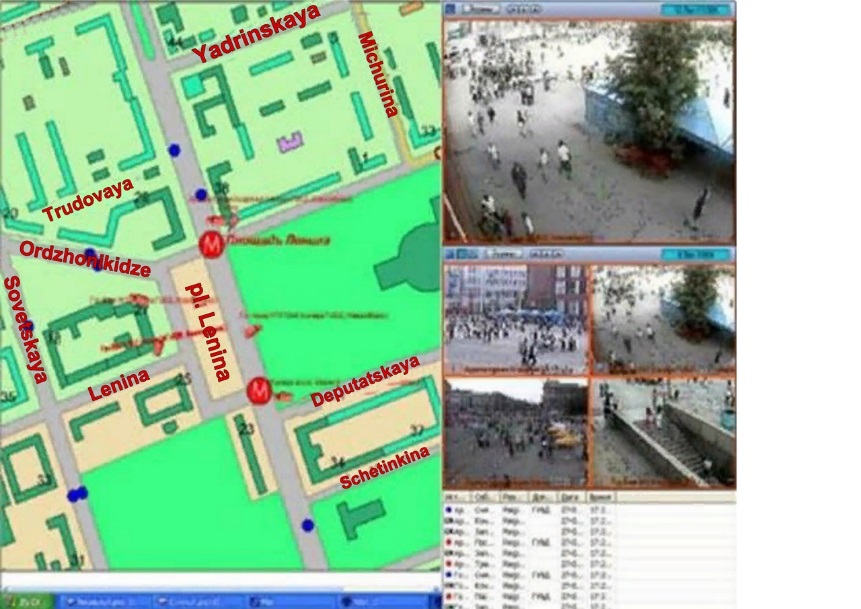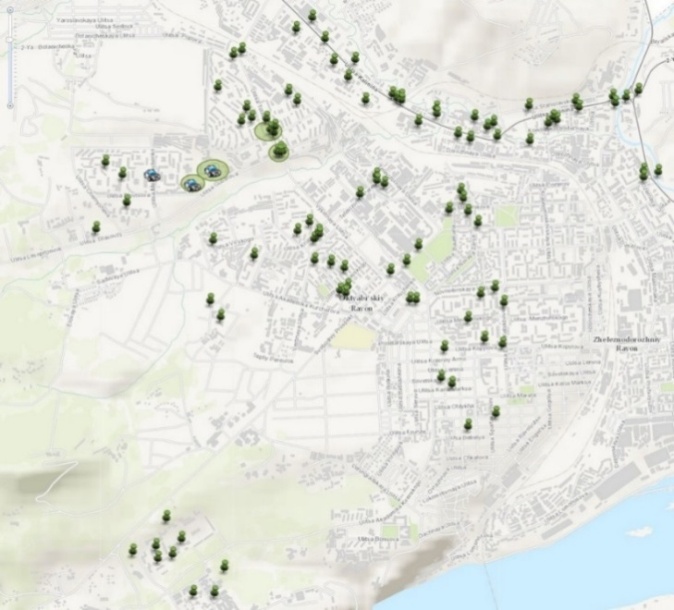Abstract
The article is devoted to the issues of ensuring security for the protection of law and order in order to reduce crime. The basic principles and goals of ensuring criminological security, as well as the admissibility and effectiveness of the use of video surveillance equipment and the processing of video surveillance are considered. The issue of practical implementation of video surveillance systems with the aim of reducing crime has been studied. An experiment was carried out with statistical data for a month, on the basis of which a conclusion was made about the need to place a video surveillance unit in one place or another. In order to check whether the decision made to place video surveillance in exactly the places that are required, one more testing is carried out based on the data for the next month, in order to verify the correctness of the previous decision, which allows one to really assess the quality of the developed method and the final result obtained on the basis of this method.
Keywords: Security, protection, criminology, video system, surveillance, adaptive system
Introduction
Currently, the state and directions of development of the criminological situation in the country show that the established approaches to organizing a policy of combating crime, to the perception of the tasks and goals of work in this area of public relations, methods and means of achieving them, formed over decades, cannot guarantee the safe life of society. At the moment, the official point of view of the state in this area is to understand the need to reduce the number of crimes that are becoming the only object of law enforcement activity. With this approach, citizens who are likely to become victims or have already suffered from crimes are often left without appropriate social and legal anti-criminogenic protection and without compensation both because of the lack of its state security and from the damage caused (Datola et al., 2020, Dong et al., 2020).
Street crime is understood as a complex of crimes committed on the free infrastructural territory of a settlement with uneven social control and unlimited access.
Problem Statement
Work to ensure criminological security is interpreted as one of the highest priorities and is associated with guarantees, and occasionally restriction of constitutional rights and freedoms of citizens, with the involvement of many state and non-state bodies, public organizations and citizens in this area, it is necessary to determine the main principles of this work (Obedin, et al., 2019).
So, now you should list the main of these principles related to ensuring criminological security (ECS) (Datola et al., 2020; Oc & Tiesdell, 1999):
- The advantage of protecting the rights and freedoms of citizens from criminal attempts.
- Legality.
- The totality of a range of different areas of criminological security.
- Preemptive influence on the causes and conditions conducive to criminal acts that lead to the appearance of threats of criminal attempts.
- Appropriate response to threats of criminal encroachment on objects of criminological security.
- Ensuring the productive efficiency of the state crime prevention system.
- Ensuring the persistence of preventive influence on subjects of criminal and pre-criminal behavior and lifestyle.
- Ensuring the prevalence of preventive measures, prevention and suppression of criminal actions in order to prevent crimes or the onset of their negative consequences.
- Participation and mutual activity of all structures with a combination of centralized and decentralized control of forces and means of the ECS.
- Integration with international ECS systems.
- Controllability of the ECS system to state and public institutions.
Research Questions
The implementation of the functions of the ECS can occur in various types of activities. At the heart of the ECS activities are three directions, which are the basis of the classification: the first is the impact on the threat in order to eliminate it, neutralize it or otherwise transform in its own interests, the second is to protect the object from criminal encroachment, and the third is victimological prevention, that is, ensuring security a potential victim of a criminal offense from a criminal attempt (Ballesteros et al., 2012; Tubaishat & Elsayed, 2017).
Purpose of the Study
The purpose of ensuring criminological security is to create and maintain a level of criminological security acceptable to society.
Research Methods
Scientific and technological progress includes various spheres of human life. An example of its expression in today's everyday life is the general popularization of video surveillance equipment. The range of use of these tools is very extensive: closed circuit television (CCTV) cameras and control by the chief over the work activities of employees; video systems that control the production process; infrared video cameras that are equipped with a motion sensor, guarding the border; a road monitoring system that monitors compliance with the speed limit, reads and verifies the registration plates of vehicles, checking vehicles in databases on many parameters (for example, is the car stolen) (Li et al., 2014; Zeng et al., 2019).
In accordance with the current criminal procedure legislation, materials from CCTV cameras can be evidence in a criminal case.
Many studies that have been conducted confirm that video surveillance systems are a very useful and effective security solution. According to the research, it can be concluded that video surveillance systems are effective measures to protect citizens and ensure their safety. Hence, we can confidently say that the use of video surveillance systems leads to high stability in society (Donald & Donald, 2018; Pan et al., 2020).
Over the past few years, video surveillance has had a high impact on protection against criminal attacks and antisocial behavior. Also, CCTV cameras provide peace of mind for visitors to places such as large shopping centers, business centers, and other places of large public gatherings. People who use video surveillance systems outside their own territory have the ability to control everything that happens there at any time of the day (Ju & Yi, 2013).
Proceeding from the practical actions of the internal affairs bodies, places of large public congestion are equipped with external video surveillance cameras (for example, in parks, in squares, in the adjacent territories of shopping centers). Notification from CCTV cameras comes to a special transmitter, which is designed to transmit information to local computer video control centers. In such centers, the process of information processing and its transmission through the fiber-optic network to the Central video surveillance post takes place. Such a post is equipped with a direct audio-communication channel and a mode of video exchange of information with police departments and an emergency communication kit "panic button" for calling the task force when committing illegal actions. Police crews on cars are involved for a prompt response.
In the event of a criminal situation, video surveillance systems allow you to record the process of committing a crime and criminals through video recording. The resulting video becomes one of the most important evidence in court and should be used along with the testimony of witnesses, traces seized during the inspection of the scene.
With the help of video surveillance systems, you can get an external description of any object. This description consists of structural, surface and dynamic characteristics. For example, a description of a person's appearance includes noticeable anatomical features, details of clothing and footwear, and functional features. To identify objects, it is necessary to have a set of features characteristic only for this object, and their relative stability. Then there will be only one point in the feature space corresponding to this object.
It is known that a person has an individuality (uniqueness) of appearance and relative stability of signs. The identification process consists in comparing two (or more) sets of features with each other. Therefore, for identification, it is necessary to highlight these features. When describing a person's appearance with large facial elements that have criminally significant features. These include the following: scalp, forehead, eyebrows, eyes, eyelids, cheeks, nose, nasolabial filter, lips, teeth, chin, ears. However, in a large element with an in-depth study of it, the following components can be distinguished: when describing the eyes - the structure of the palpebral fissure, protrusion of the eyeballs, the view of the inner corners of the eyes; when describing the nose - the bridge of the nose, the bridge of the nose, the base of the nose, the wings of the nose. Moreover, each element of appearance can be characterized by the following features: shape, size, position, color. Paired elements also have symmetry or asymmetry. Each sign has three values of severity (two extreme and one average). According to experts, the total number of people from which each person can be distinguished by the combination of these characteristics will be equal to 950.
However, in practice, due to the influence of various factors, the number of features is reduced, and their display changes. The completeness of the display of features can be expressed in the number of features or the probability of identification. If the displayed number of signs is sufficient for a categorical answer, then the recognition probability is equal to one.
As you know, in the work on solving crimes, the time factor is of great importance. Most of the crimes are solved as a result of the hot pursuit of criminals. Therefore, the sooner the police become aware of the crime committed, the more real the possibility of quickly detecting and arresting the offender. This is explained by the fact that criminals sometimes spend some time after committing a crime at transport facilities, may retain traces of the crime and have objects obtained by criminal means.
Using modern methods of receiving and processing information from CCTV cameras, it is possible to continuously collect and transmit, intelligently analyze and archive video data from a large number of cameras with the ability to instantly display and access video archives from operator workstations. It is recommended to install cameras protected from intruders on the territory of the city in the most criminogenic places (for example, in the entrances of residential houses and other places of large and vice versa very low crowds of people).
Despite the numerous problems and ambiguity of views on the use of video surveillance systems, practice shows that they can significantly increase the effectiveness of law enforcement agencies in the field of public order protection. Despite the fact that CCTV cameras do not serve as a guarantee of crime prevention, they are still required in order to help in catching a criminal and increasing the chance of solving crimes, as well as protecting their rights and freedoms, life and health.
Video surveillance systems make it possible to collect irrefutable evidence in solving crimes. With the help of recordings from CCTV cameras, it becomes easier to identify the identity of the offender, methods of offenses, the sequence of events, as well as additional information about incidents.
The key factor is the hardware parameters. Currently, high attention is paid to the quality of shooting, therefore, in the event of criminal actions, it will be decisive, for example, to identify the brand of the vehicle, its color, registration plates, as well as the faces of people in this vehicle. Video cameras are of great help in securing places where criminal activity is more likely to occur. Such places include shopping malls, shops, offices, preschool and educational institutions, and other public places. Installation of surveillance cameras is a serious crime prevention, because a criminal simply will not commit criminal actions where there are video cameras capable of exposing him. Even if the crime was committed "behind the scenes", cameras still record what is happening on the main roads and, having watched the recordings or a live picture, you can understand where the offender went.
Findings
The system provides joint operation of video monitoring, notification and information system subsystems. At the same time, the ability to both local control of each of the subsystems and the ability to control and manage the entire system from a common center is mandatory. The system must include a global storage of information. In addition, the system must provide operational communication between the dispatching offices and all units providing security in the city.
The scheme of video surveillance is shown in figure 01.

The proposed solution can be easily integrated with all known applications. Integration will provide the ability to recognize faces, license plates and many other functions (figure 02).

Since this information system (IS) should form the location of the object, it follows that the source of information is the customer's preferences and directly such information as specific types of incidents, on the basis of which the location is formed. The specified primary information is entered into the system by the responsible employee, after which the IS calculates all possible options for the location of the object.
Statistics for a month are taken, on the basis of which we get a result about the need to place a video surveillance node in one place or another. In order to check whether the decision made to place video surveillance exactly in the places that have been chosen is valid, one more testing is carried out based on the data for the next month, in order to verify the correctness of the previous decision. This allows you to really assess the quality of the developed method and the final result obtained on the basis of this method.
The results of the experiment are clearly shown in figure 03.

As a result, when developing a solution, we get:
- Worldwide united network of video monitoring.
- Integrated archive of collection and storage of video information.
- Tracking systems for access to attics and basements.
- Points of contact with emergency services.
- Ensuring the safety of preschool and educational institutions.
- Video monitoring and reading of faces in public places (for example, at train stations or airports).
- Video monitoring and reading of registration plates of vehicles, control of vehicles and roads.
Conclusion
Thus, it should be noted that the widespread introduction of video surveillance in the residential sector will only improve living conditions, because it is difficult to overestimate the role of security cameras in preventing and solving crimes. Video monitoring of the city's criminal areas makes it possible to speed up the police response to criminal acts and increase their detection rate, as well as to fight petty street crime and administrative offenses, which is a breeding ground for them.
References
Ballesteros, J., Rahman, M., Carbunar, B., & Rishe, N. (2012). Safe cities. A participatory sensing approach. 37th Annual IEEE Conference on Local Computer Networks, 626-634.
Datola, G., Bottero, M., & De Angelis, E. (2020). Addressing Social Inclusion Within Urban Resilience: A System Dynamics Approach. International Symposium: New Metropolitan Perspectives, 510-519.
Donald, F. M., & Donald, C. (2018). Is CCTV surveillance as effective as popular television crime series suggest? cognitive challenges.Congress of the International Ergonomics Association, 413-420.
Dong, C. Z., Bas, S., & Catbas, F. N. (2020) A portable monitoring approach using cameras and computer vision for bridge load rating in smart cities. J. of Civil Structural Health Monitoring, 10(5),1001-1021.
Ju, Y. W., & Yi, S. J. (2013). Implementing Database Methods for Increasing the Performance of Intelligent CCTV.Int. J. of Security and Its Applications, 7(5), 113-120
Li, Y. H., Zhang, X. D., Feng, Z. C., & Luan, Z. H. (2014). Research on the key equipment performance of stage video surveillance and scheduling system based on IP Network applied. Mechanics and Materials, 644, 957-960.
Obedin, A. V., Soroka, E. O., Kukartsev, V. V., Mikhalev, A. S., Tynchenko, V. S., Semenova, E. I., & Bashmur, K. A. (2019). The developing program system of social monitoring of road improvement and urban infrastructure. J. of Phys.: Conf. Ser. 1399(5), 055021.
Oc, T., & Tiesdell, S. (1998). City centre management and safer city centres: approaches in Coventry and Nottingham. Cities, 15(2), 85-103.
Oc, T., & Tiesdell, S. (1999). The fortress, the panoptic, the regulatory and the animated: Planning and urban design approaches to safer city centres.Landscape Research, 24(3), 265-286.
Pan, X., Hu, H., Xu, J., & Li, M. (2020). Research on video surveillance robot based on SSH reverse tunnel technology. 2020 3rd International Conference on Advanced Electronic Materials, Computers and Software Engineering (AEMCSE), 298-302.
Tubaishat, A., & Elsayed, R. (2017). Safe city: Introducing a flawless model and implementation guidelines to reduce crime rate and response time. Proceedings of the 29th International Business Information Management Association Conference - Education Excellence and Innovation Management through Vision 2020: From Regional Development Sustainability to Global Economic Growth, 474-485
Zeng, X., Guo, H., & Hu, W. (2019). Design and Implementation of Shipping Video Surveillance Equipment Based on Raspberry Pi. 2019 IEEE International Conference on Computational Science and Engineering (CSE) and IEEE International Conference on Embedded and Ubiquitous Computing (EUC), 66-70.
Copyright information

This work is licensed under a Creative Commons Attribution-NonCommercial-NoDerivatives 4.0 International License.
About this article
Publication Date
17 May 2021
Article Doi
eBook ISBN
978-1-80296-106-5
Publisher
European Publisher
Volume
107
Print ISBN (optional)
-
Edition Number
1st Edition
Pages
1-2896
Subjects
Science, philosophy, academic community, scientific progress, education, methodology of science, academic communication
Cite this article as:
Kukartseva, O. I., Tynchenko, V. S., Lytkina, S. I., Stupin, A. O., Makarchuk, I. Y., & Kurashkin, S. O. (2021). Ensuring Criminological Security Of The Society Using An Adaptive Video Surveillance System. In D. K. Bataev, S. A. Gapurov, A. D. Osmaev, V. K. Akaev, L. M. Idigova, M. R. Ovhadov, A. R. Salgiriev, & M. M. Betilmerzaeva (Eds.), Knowledge, Man and Civilization - ISCKMC 2020, vol 107. European Proceedings of Social and Behavioural Sciences (pp. 2253-2259). European Publisher. https://doi.org/10.15405/epsbs.2021.05.299

